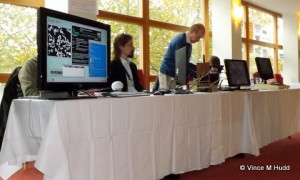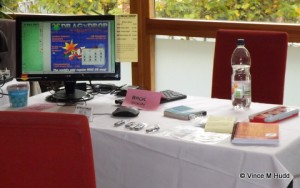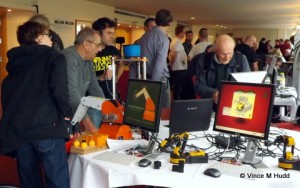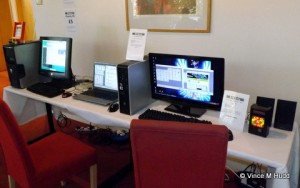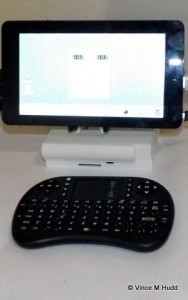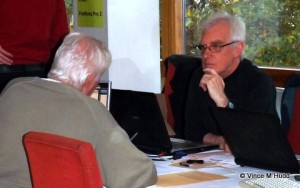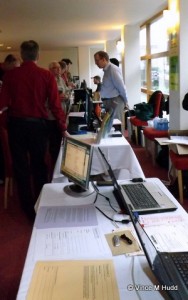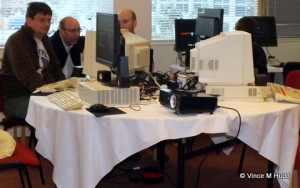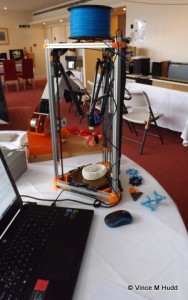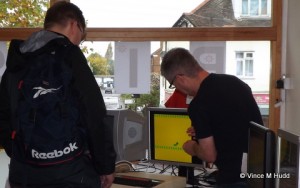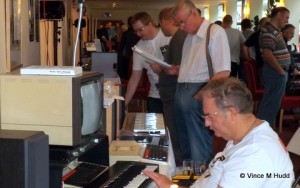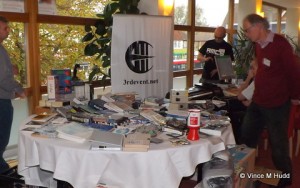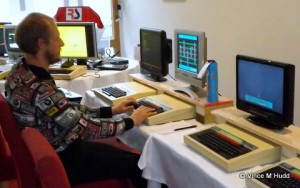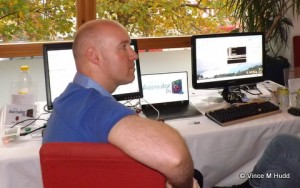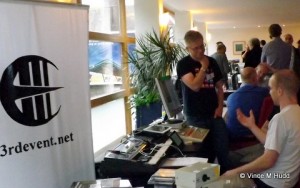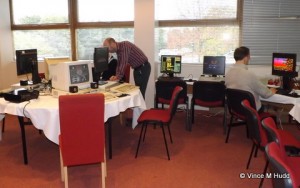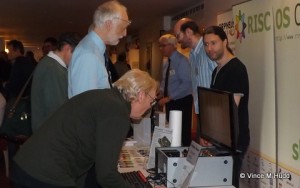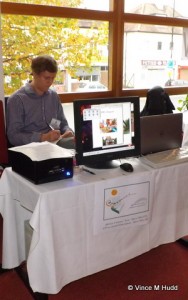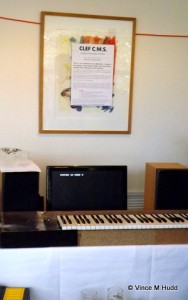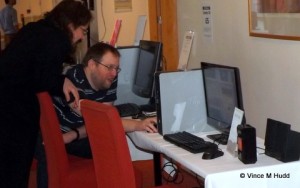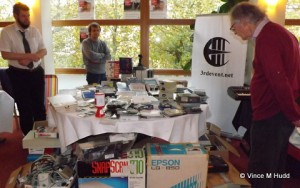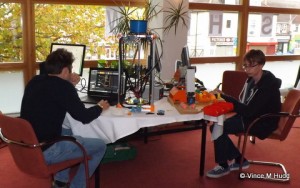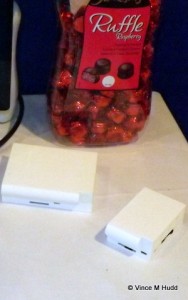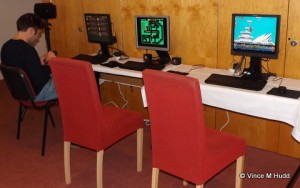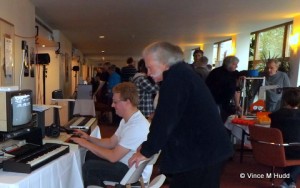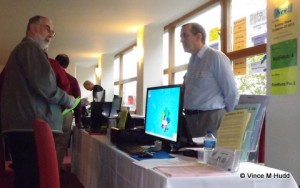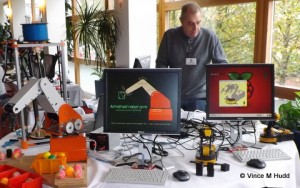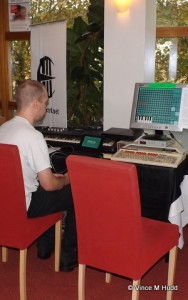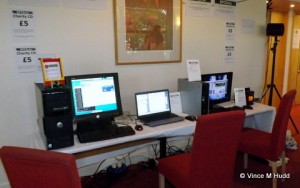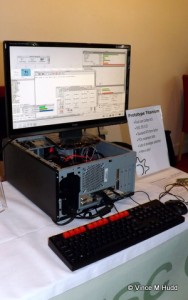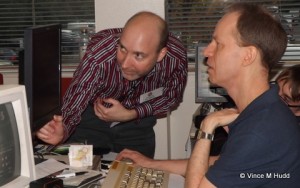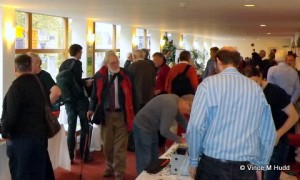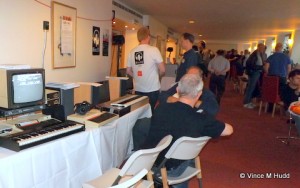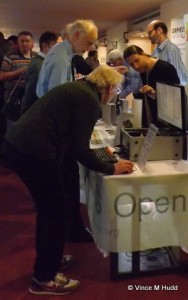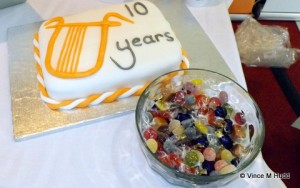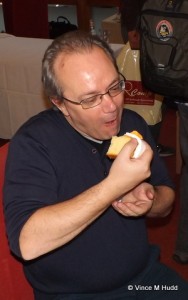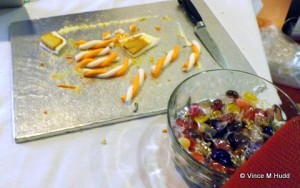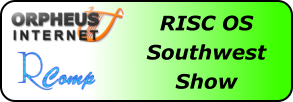The who and the what. The only why is why weren’t you there?
The 2015 RISC OS London Show took place on 24th October, 2015 – and while the number of visitors was (I believe) just shy of 110, there were plenty of RISC OS users unable to attend. So what did they miss?
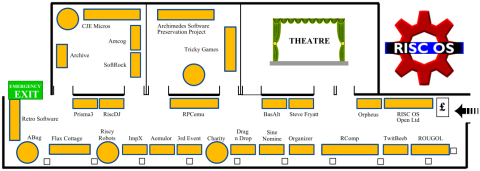
I’ll take a clockwise trip around the show for this report – a decision made without the usual flip of a coin, because I have a cunning plan: That direction keeps something a bit special until last (unless you watch the YouTube videos of the theatre talks, but I’ll pretend I haven’t considered that possibility!)
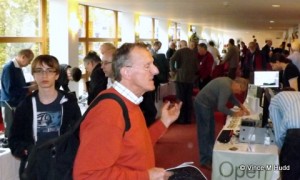
ROUGOL
After paying an entry fee and getting (while stocks lasted) a free copy of Hack Circus magazine, the first stand to see would be the organising user group’s own stand. ROUGOL – the RISC OS User Group of London – were immediately to the left of the entrance, persuading people to join them on the third Monday of each month, when they more often than not have some very interesting guest speakers.
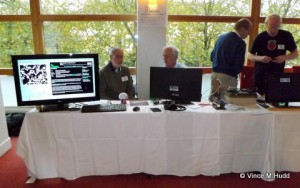
burrBeep
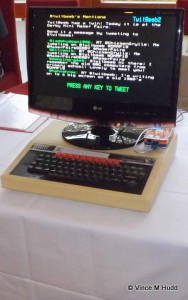
Immediately after ROUGOL was – according to the exhibitor list – TwitBeeb, with David James Lennon on hand to describe how it all works. However, this wasn’t quite correct.
TwitBeeb is a BBC Microcomputer which has been interfaced with a Raspberry Pi by Barney Livingstone, and through which whoever is using the BBC is able to access Twitter. What David has done is use the same code to produce what can best be described as TwitBeeb’s younger sibling – burrBeep (aka Twit Twoo – as in the second one, geddit?). The original TwitBeeb was actually at the Derby Mini Maker Fair, which took place on the same day as the RISC OS London Show but, er, in Derby.
Anyway, that minor point of confused identity aside, burrBeep provided a live Twitter feed on the day – and when I attempted to send a tweet was the moment it decided to stop working, and needed fixing. In general, though, I’m told it worked nicely throughout the day (a claim which is easily supported by looking at the @burrBeep Twitter account).
Obviously, there’s also the option of just using the Pi itself to access Twitter (along with any other website) – but where would be the fun in that?
R-Comp
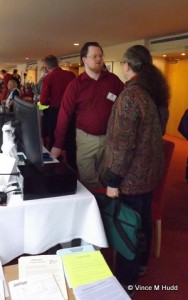
Next up was the R-Comp stand, where a wide range of hardware (both native ARM-based, such as ARMSX ARMX6, and running RISC OS under emulation, such as their RisCube range) and software was available.
Amongst other things, R-Comp had a curved 34″ ultra-widescreen monitor on their stand. With a resolution of 3440×1440, it really was impressive. While it’s not uncommon to see people with two monitors side by side on their desks, both providing a display from a single computer (aka a ‘dual head’ system) and therefore providing more screen real estate, in many cases this single unit could be used instead.
Quite interestingly, just over a week after the show, R-Comp’s Andrew Rawnsley commented on the ARMini-Support mailing list that he had found it far more difficult to get the monitor working on a computer running Windows than it had been with an ARMX6 running RISC OS.
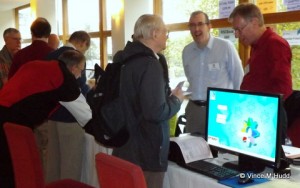
Andrew gave the second theatre presentation of the day, in which he started by talking about the ARMX6 and what has happened since last year – for example the improved display options – which led him neatly onto the subject of monitors and the one mentioned above.
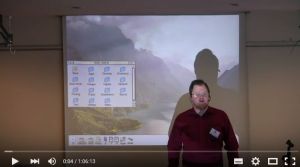
On the software front, amongst other things he talked about the newly released Fireworkz Pro 2, which can now save as Excel files, and has over 100 new functions that are mapped correctly to their Excel equivalents. If an Excel workbook is loaded that has multiple sheets, these are loaded as separate Fireworkz documents – and on a suitably fast machine, it appears to do this very quickly.
North One Communications/Organizer
Next to R-Comp was North One Communications with Organizer, the – no THE – personal information manager for RISC OS. A new version of the software was available at the show, where Nigel Willmott and Martin Avison were discussing the software with visitors.
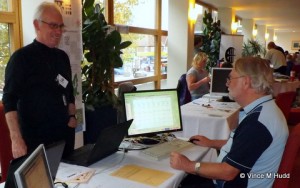
The new version – 2.24 – provides more support for Sine Nomine’s mapping software, RiscOSM, allowing you to find map locations for your Organizer contacts with just a click, even if your details don’t include the postcode. It also includes improved iCal and notes handling.
Sine Nomine
Neatly enough, then, the next stand was home to Sine Nomine, where Matthew Phillips was demonstrating and selling RiscOSM! Matthew gave the third theatre presentation of the day, talking about the software’s background and demonstrating many of its features:
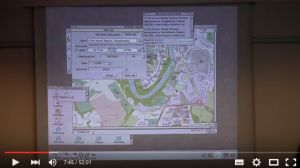
New to the show was version 1.29, in which new features include a map key that also allows the displayed map detail to be customised, and a thumbnails panel for geo-located photographs and the ability to fetch photos from Geograph (though it is only able to do so for the British Isles and Germany at present).
If you don’t have the software (yet?) but do have access to something that works with Google Maps, this strikes me as offering similar functionality to the “Show Imagery” button, which opens a strip along the bottom of the web browser window – with the key difference that Google only show images made available via their own services, such as user uploads to Panoramio.
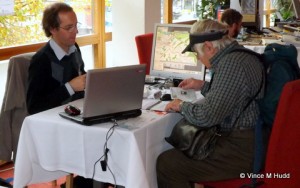
Drag ‘n Drop
Christopher Dewhurst was on the next stand, representing on-off-on-off-under-new-management PDF magazine Drag ‘n Drop.
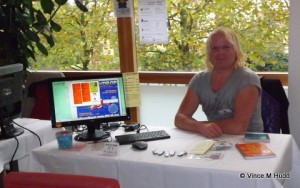
A new issue – the first of volume seven – was available from the day of the show, and as usual Chris was selling this on a USB memory stick, bundled with every issue produced so far.
Charity Stand
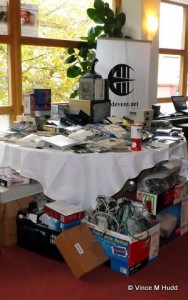
After Chris, the charity stand was selling all manner of goodies, old and, er, even older, in order to raise money for Combat Stress – a charity aiming to provide support to veterans suffering from psychological effects after their time in the services.
Amongst the things on offer was an Acorn Electron that had already been sold on the stand at last year’s show. That time, it wasn’t working – but it hadn’t been returned as a result; Peter Howkins bought it last year and subsequently repaired it, donating it to the charity stand again to be sold as a working item this year. Nicely done!
The stand managed to raise a whopping £480 for the charity this year – so well done to those manning it, as well as to those who either donated items for sale, or who purchased anything from it.
3rd Event Technologies
A raucous racket Some pleasant sounds could be heard coming from the next stand, where 3rd Event Technologies were demonstrating AMCS – their Advanced Music Construction System.
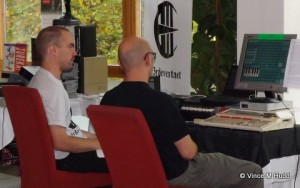
The software – an embedded music production operating system – runs on an A3000, but not on RISC OS as such, since it is an operating system in its own right. Indeed, the system has also been ported to another ARM-based computer – a low-cost netbook-type device, which doesn’t have RISC OS running on it in the first place.
Whichever hardware it runs on, because the software doesn’t need a separate operating system and therefore doesn’t suffer any of the overheads they bring with them, it runs very efficiently.
Aemulor
After 3rd Event, Neil Spellings and Adrian Lees were demonstrating Aemulor, a piece of software whose origins date back to the IyonixPC. It was originally written to provide a bridge between the old 26-bit RISC OS world and the new 32-bit one, allowing 26-bit only software to run on the 32-bit only IyonixPC – and has now been adapted to work on more modern platforms, such as the Raspberry Pi, etc.
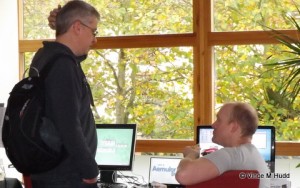
The boys were showing off a new version at the show, which has yet to be released, with final plans still to be formulated. It’s possible this may be released as a single, commercial update for all the modern RISC OS platforms, under an ‘Ultimate’ banner – so there had better not be any new platforms requiring new versions, then, otherwise it will have been given a silly name!
Impression-X
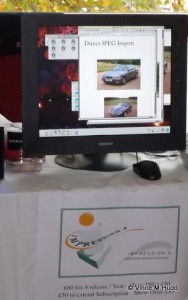
Richard Keefe – who I can’t seem to stop calling Keith whenever I speak to him, so will henceforth be referred to as Keith Richard Keefe on RISCOSitory – was next with Impression-X [website still to come], the ongoing development of a 32-bit version of Impression.
Richard told me that things are progressing nicely – albeit very slowly, considering the amount of work involved – and as well as bug fixing and the 32-bit conversion work, new features are being added where practical as well. The current release, for example, features direct import of JPEG images.
Richard said he was very close to releasing his third update to the software, and expected the fourth to be ready around the time of the 2016 Southwest Show.
Riscy Robots
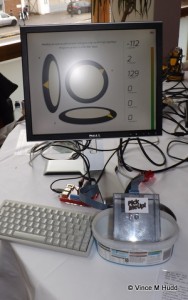
For the last few years, Neil Fazakerley has brought a selection of robot arms to the show, along with another neat little project involving interfacing a Raspberry Pi (running RISC OS, with his software written in BBC BASIC) to something – last year, for example, that something was a train set.
This year, Neil had brought along an accelerometer – a device often found in mobile phones and tablets, and which is commonly used to automatically reorientate the display according to which way up the device is being held, and is sometimes even used as the control mechanism in simple games.
Visitors could pick up the device, and the attached Pi – of course running RISC OS – would show the orientation in three axes on the attached display.
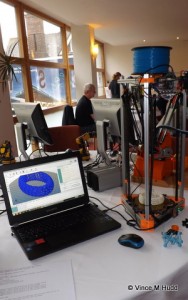
Also on the stand, Neil’s son had brought along a 3D printer – although there is no software to control it from RISC OS – and it was being used to print various items as the day progressed (albeit vvveeerrryyy ssslllooowwwlllyyy – because it’s not a quick process!)
Flax Cottage
Moving into the retro world, Flax Cottage were showing off a collection of educational software from their archive, dating back to the 8-bit days, when educational software for the BBC Micro was a big thing. Details of their collection can be found on this Stairway to Hell forum post – as far as I can see, Flax Cottage don’t have their own website.
Some of the software was running on the original hardware, and some was running on a Raspberry Pi via RISC OS Pico, the BBC BASIC environment released by RISC OS Open last year.
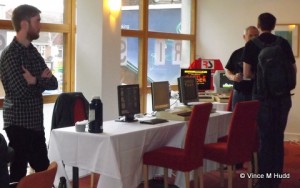
Retro Software
At the far end of the hall, Retro Software [website MIA as I type this] had a variety of old 8-bit computers set up, running a selection of games, and running a High Score competition (playing Chuckie Egg and Acornsoft Monsters) to win a tub of Celebrations.
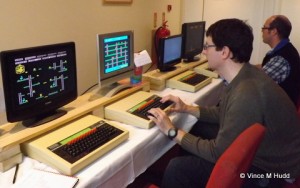
Peter Howkins apparently achieved a score of over 250,000 in Chuckie Egg, winning the prize for that game – and was later complaining about toothache. However, that was apparently just a coincidence, because the toothache came before the chomping of the sweeties. For Monsters, the winner was someone called Kevin. Kevin who? I don’t know, but with a score of 11,580 it’s hardly worth worrying about: I could beat that while sleeping – i.e. in my dreams!
Prisma 3
Starting to work back down the hall, the next port of call for the visitor was the Prisma-3 exhibit, which was brought along by the Emertons – who also had the next two stands, detailed below.
The Prisma-3 Graphics System was an add-on for Acorn computers from Millipede that could provide a genlocked graphics display – thereby allowing computer graphics to be overlaid on and synchronised with ‘live’ footage.
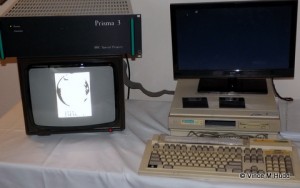
Unfortunately, while the system was itself running (via an Archimedes), it only appeared to be showing a graphic – a black and white BBC globe – on the attached screen, with nothing to really indicate that it was anything other than an image being output by the computer on a monitor.
As such, it was somewhat disappointing – but Paul Emerton explained that a big factor in this was the same problem we all suffer from: a lack of time. The system came as just a disorganised collection of hardware, and they had some problems getting it up and running to start with, not to mention trying to write some software to make use of it. It’s possible the Prisma-3 may appear again next year, hopefully, with something a little more interesting to show off its capabilities.
Music 5000 and CLEF
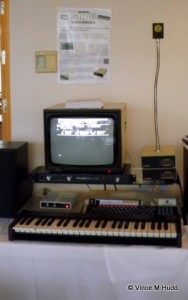
Things continued to be old school on the next stand, where Paul Emerton had some retro music creation gear on display: A Hybrid Music 5000 system, and a CLEF CMS synthesiser.
The Hybrid Music 5000 Synthesiser was an add-on for Acorn’s 8-bit computers that turned them into fully fledged synthesisers, programmable via a language called AMPLE.
The CLEF CMS is an alternative synthesiser system for the BBC Micro, which originally came in two versions – one of which was a complete system, and the other a DIY version. The one at the show was the latter, for which a rough wooden case had been constructed, with a keyboard taking up most of the space to the right, and the CLEF system itself visible to the left.
RiscDJ
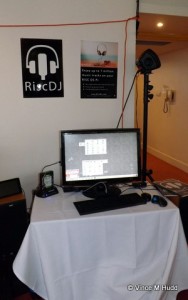
Michael Emerton’s RiscDJ [website MIA] stand was not as extravagant this year as it has been in previous years: Gone was the professional display stand with multiple monitors attached, to be replaced with something more akin to what most exhibitors had: a computer (or computers) and peripherals on a table.
RiscDJ provides a very slick full screen display of its user’s digitised music collection, providing some comprehensive search facilities to narrow down the selection shown, and therefore to choose from – and I’m pleased to say that at the point I looked, a quite reasonable selection was being displayed: Mainly a selection of Bond themes (although that may not have been the result of a search, given some of the songs listed immediately before them, which bore no obvious relation at all; this was just an alphanumerically sorted list).
Amcog Games
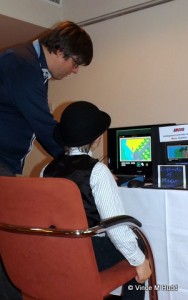
Nipping into the first (er, furthest) side room, Anthony Bartram of Amcog Games was showing off his new game, Legends of Magic, which has been in development in the months leading up to the show.
The game is an isometric 3d adventure, in which the player takes the role of a character tasked with finding an evil wizard and sealing him into the alternative dimension to which he has been banished – but where he doesn’t want to go, and uses monsters, undead monks, and other obstacles to avoid being caught and sent there.
I quite like this dimension, so the wizard’s point of view is quite understandable: If I was him, I’d probably try to stay put, as well.
CJE Micro’s
Also in this room, CJE Micro’s had their usual extensive selection of goodies – software, hardware and a wide range of peripherals.
One of the items of hardware, of course, was their IGEPv5-based computer, for which CJE recently ran a “Name that Tune Computer” competition. We now know the result of that; the computer is called the Eastwood RapidO Ig, a name derived from a suggestion made by Adrian Lees.
Why the ‘Ig’ suffix? Ah, well, remember at the start of this report, when I mentioned there being something special that I wanted to keep until the end? It’s to do with that – but, as I also said, there are spoilers in the theatre presentations, so if you don’t want to know what I’m talking about just yet, you should probably not watch the first talk of the day, given by Chris Evans:
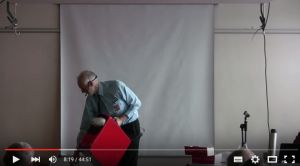
However, for those who did watch it, and who would like a better look at what Chris held up – because, as ever, Chris holds things up for people to squint at, here’s a photograph of it – everyone else, close your eyes now:
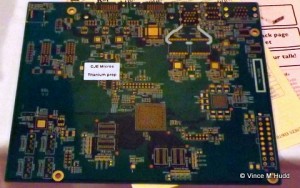
I only use fairly low-res photographs in these show reports (which helps make the pictures look better than they really are), but that still provides a better look at the board than holding it up for the audience instead of displaying a decent picture of it using the projector! (Yes, I will keep saying this: Chris, use the projector, PLEASE!)
He also showed off a rather nice red case, and this, in conjunction with a working version of the above board (which, sadly, wasn’t available on time), was going to be the large, red prototype mentioned in CJE’s pre-show announcement – though CJE only have a small number in stock, so it’ll be a case (hoho) of first come, first served and, once gone, they’ll switch to another suitable case. Borrowing the IGEPv5 computer’s name, this will be the RapidO Ti.
Anyway, those readers who didn’t want to see that item just yet can now open their eyes again.
During his talk, as well as the above, er, “mystery” item, Chris discussed a few other things. On the software front he mentioned Tablemate and Photodesk. With the former, he has for years wanted to get it updated, but there are some parts of the source code missing; the author says he has sent them (twice) on floppy disc, and that he will send them again – so there is hope here. In the case of Photodesk, things did stall for a while, but there has now been a little more work done towards getting it to work properly on newer hardware.
The subject of the Raspberry Pi ‘Compute’ module-based laptop came up, and the audience was told that there had been lots of hurdles and that CJE are still hoping to make progress with it. However, there is an alternative, in the form of the Pi-Top, a Raspberry Pi-based laptop developed through crowd-funding on Indiegogo. Production is already committed to fulfilling orders until some time in December, but Chris hopes that once that’s out of the way, they’ll be able to add them to the ever-growing CJE Micro’s stock list, bundling them with RISC OS.
Soft Rock Software
The final stand in this room was manned by yours truly, representing Soft Rock Software and RISCOSitory. As per usual, this was a stand to head for if you wanted sweets, which this year were Raspberry flavoured Ruffles, hugely appropriate because – at long last – the RiscPiC-mini case for the Raspberry Pi is a finished product; it now accommodates any of the original Model B, the B+ and the version 2 Model B.
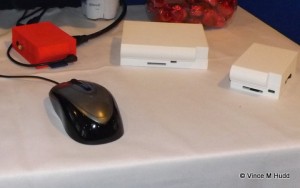
And not only was the case ready, it was available to buy – because for this show, I actually remembered to bring them along, something I’ve failed to do with the previous version of the case at more than half the shows I’ve attended since last year’s London Show. Ahem.
Now all I have to do is get the ‘standard’ case designed and working – so keep an eye out for a disappointed looking me at the next RISC OS show, because I’ve either failed to get it working, or just forgotten to bring it.
Archimedes Software Preservation Project
One of the exhibitors in the second room was Jon Abbott and his Archimedes Software Preservation Project, the aim of which is to collect and preserve original games for RISC OS computers, making them available to download and run on modern hardware – which is done using his ADFFS emulation software.
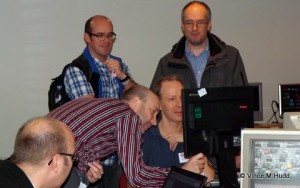
Jon was demonstrating progress made through the project, with a selection of games available to play on a range of computers, including real Archimedes systems, and a Raspberry Pi.
Tricky Games
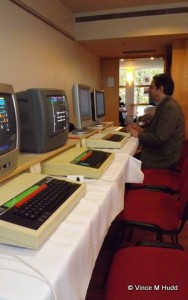
Also in this room was the Tricky Gaming retro arcade. Richard Broadhurst had a number of old computers set up, on which a number of old – and, apparently, some new – games were available to be played.
Richard himself isn’t in the photograph to the right (assuming this is being read on a system that displays images where I’ve positioned them!) This is because when he spotted me pointing the camera at the stand, he quickly moved out of the way. This, he said, wasn’t to avoid being in the picture himself, but because the pint he had in his hand was camera shy.
Unfortunately for that pint, then, Richard spotted me too late – the picture to the right was the second one I took, after already having taken the one below.
So, to quote Nelson Muntz from the Simpsons, “haha!”
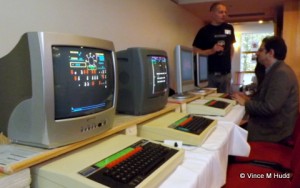
RPCEmu
Back in the main hall, Peter and Matthew Howkins were demonstrating the latest version of RPCEmu, a RiscPC/A7000 emulator for Windows, Linux and Mac OS X, and selling copies of it on CD for a fiver, with the proceeds going to Combat Stress.
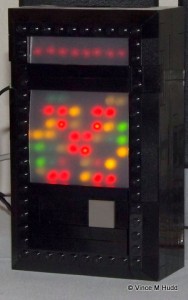
The pair had brought along twenty copies on CD, taking one back home again, and thus raised £95 for the charity.
As a bonus point of interest, their stand also featured a tribute to a BBC science fiction mini-series from 1987 called Star Cops – which, oddly, I’ve never seen. The show apparently featured a hand held talking computer called Box, and it was a recreation of this that was sitting on the table, with a push of the button on the front playing back a sampled recording of the “real” Box from the TV show.
At this point, I’d like to offer a fitting quote – but looking at the memorable quotes page for the show on IMDB, there are almost none listed, and none at all for Box.
So the only logical thing I can do is instead imagine that everyone reading this is called Dave, and quote a completely different talking computer: “I’m sorry, Dave, I’m afraid I can’t do that.”
Steve Drain
Next was Steve Drain, demonstrating both software and hardware.
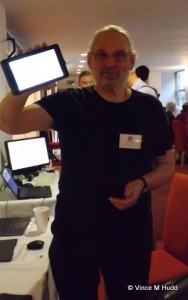
The software was Basalt – short for BASIC Alternative keywords – a module that extends the BBC BASIC language by re-purposing some keywords to extend their use (so it’s really BASIC Alternative uses for keywords, then, isn’t it?), which Steve has developed over the course of many years.
The hardware was the latest attempt at a neat little case for the Raspberry Pi. Previously, Steve has housed his Pi in a small case that sits neatly to the rear of a Motorola Atrix Lapdock, thus putting the Pi in a small laptop/netbook form factor. This time, the Pi (a model A) was housed in a tablet-style case – though, since RISC OS lacks touch screen support, it still needs a keyboard and mouse (or touchpad) to drive it.
Steve Fryatt
For those wanting to keep a track of their personal finances, Steve Fryatt was next with CashBook and other items of software, such as PrintPDF, Locate2, and a number of desktop games.
Sadly, I didn’t speak to Steve this time around, so I’ve no idea if any of the software has been updated in recent months – I know from conversations at previous shows that he has had very little development time available.
Orpheus
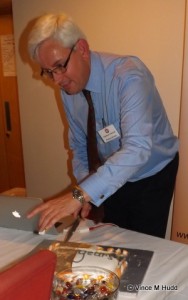
The penultimate exhibitor was Richard Brown of GeneSys Developments and RISC OS-friendly ISP, Orpheus Internet.
This has been a year of celebration for both companies, with it being Orpheus’ 10th year of business, and GeneSys’ 15th – so Richard has brought a birthday cake to all the RISC OS shows at which he has appeared during 2015.
With the London Show being the last one of the year, of course, that means no more cake at RISC OS events in the near future – so we should all look forward to another five successful years for both companies, and therefore to more delicious cake in 2020!
Oh, yeah, what was Richard actually doing at the show? Why, explaining to visitors just why Orpheus is described as the RISC OS-friendly internet service provider, providing both ADSL and Fibre broadband connectivity, and a selection of hosting packages.
RISC OS Open
And finally, we get to the RISC OS Open stand, where the usual range of software and merchandise was available to buy – from new, updated manuals, to the latest development tools.
ROOL’s Steve Revill kicked off the final presentation of the day, in which he started by commenting that there had been new faces speaking to them on the stand – which is always good to hear, since it suggests more people are hearing about and trying RISC OS.
Steve then discussed what was on the stand, and gave a brief overview of the company and its objectives, saying that they had met all of their original goals, as well as quite a few ‘stretch’ goals. All of this was kept reasonably brief, however, in order to introduce a guest speaker – Paul Fellows, who was a part of the team that originally brought us Arthur, and then RISC OS, and who gave a very interesting and entertaining account of how it came to be.
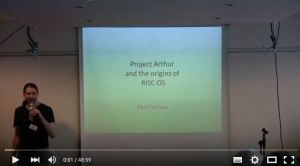
Returning to the stand itself, though, being conveniently located by the exit meant that show visitors (if they followed the route used for this report) could save the big news of the show until last.
What was that big news?
Well, one piece of equipment we all need is a keyboard. For those hankering after one that doesn’t feel cheap, feels too ‘flat’ – both of which seem horribly common with keyboards today – and especially if they miss the ‘red keys’ of the BBC and early Archimedes computers, then a new company called Elesar Ltd has come to the rescue, with a 105 key mechanical USB keyboard.
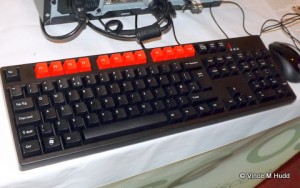
Pictures just don’t do it justice, though – the only way to really appreciate it is to use it. Take my word for it, it’s a really nice keyboard!
And, okay, the keyboard isn’t Elesar’s only product.
In the few days leading up to the show it had become clear that something was afoot, but whatever it was, it hadn’t yet been announced when I set off from Bristol on the Friday. By the time I arrived at the venue that evening, however, it had: Elesar’s Cortex A15-based Titanium motherboard.
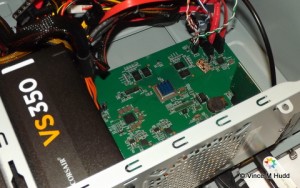
Titanium was to be the basis of the large, red prototype that CJE Micro’s referred to in their pre-show announcement: Had a board been available to them on time, they would have had RISC OS running on the board in the red case Chris Evans showed to the audience during his presentation.
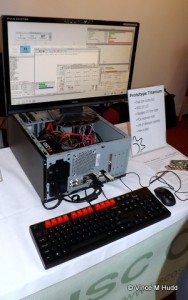
As things were, though, we did get to see RISC OS running on the board, because ROOL had one on display – but in a more mundane desktop case, which was turned around in order that the Titanium board itself could be more visible to the public.
The Titanium is based around an AM5728 SOC, with a dual core 1.5GHz Cortex-A15 at its heart (with RISC OS currently only utilising from one of those cores), and benefiting from 2GB DDR3 RAM. The board features a wealth of connectivity options, including dual gigabit ethernet (i.e. two ethernet sockets), two RS232 serial ports, four 3Gbps SATA connections, six USB 2.0 ports (with another two available via a front panel, which doesn’t come with the board), and two DVI-I video connectors.
Anyone who purchases the board itself from Elesar will have to source all the other components they need for themselves – everything from a case to the power supply – so for most RISC OS users, it’s likely that the CJE offering, once available, will be the ideal choice.
So that was London 2015.
ROUGOL’s Bryan Hogan commented after the show that “This year we had more exhibitors, more visitors (including more children), and more new/updated products! It was an excellent show, so good we booked the next one over a year in advance :-)”
That’s right, folks, the date of next year’s show is already set – 29th October, 2016 – so start planning your visit now!
Meanwhile, you may want a few more pictures of the 2015 show, in which case you could look at Bryan’s, Peter Howkins’ or a selection taken by the Stairway to Hell forum visitors and exhibitors, along with their own write ups of the event – and the rest of my own pictures are below.
